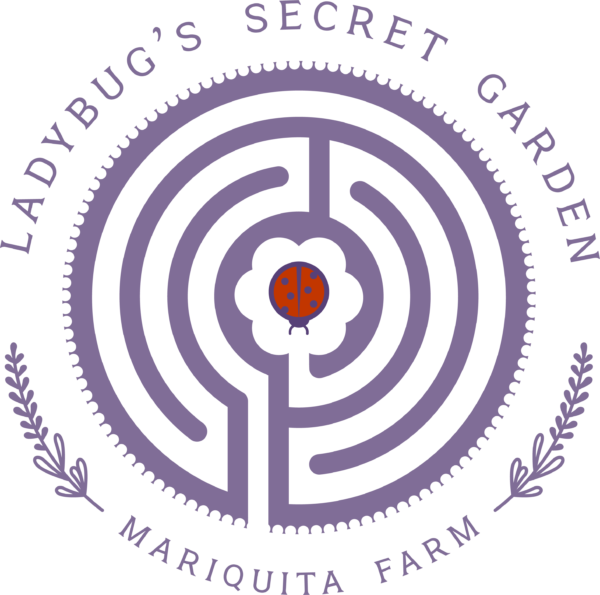Letters From Andy
Ladybug Letters
Giving Thanks!
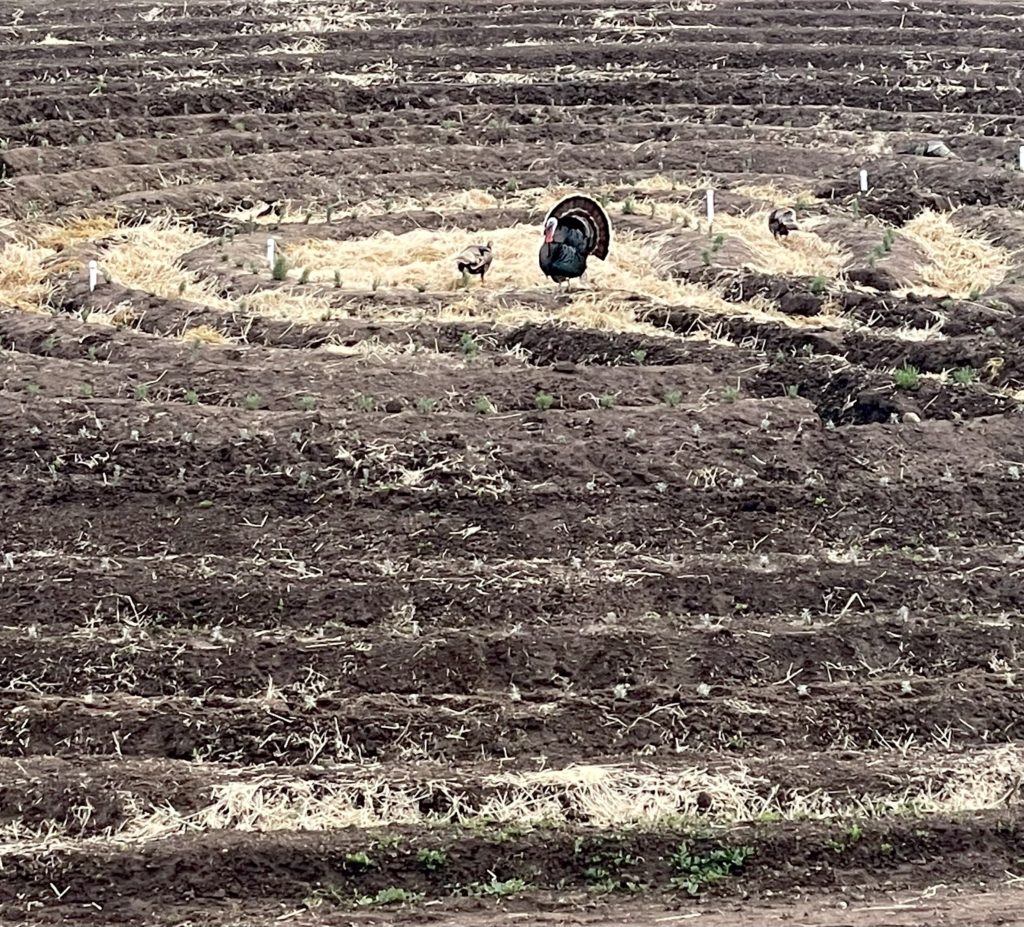
Turkeys roaming in the labyrinth.
Every day is “Turkey Day” at Mariquita Farm….but Thanksgiving only comes once a year. We have resident flocks of wild turkeys that roost in the pines in the forest at the edge of our field. It’s funny to see them hopping from bed to bed as they traverse the hand-dug 11 circuit medieval labyrinth that we’ve created in the middle of the field. When Starr created a farm store by our front gate one of the hens was captured by her reflection in the glass until I chased her off and broke the spell. When the turkey chicks hatch in the spring we see the hens lead long trains of little, fluffy, golf-balls through the grass on their daily hunt for the bugs, seeds, sprouts and greens that make up their daily diet. At first, we might see over twenty chicks trailing behind the hens. Then we’ll see 18, then 15, then 9, or fewer. The woods here are populated with fierce creatures that love to eat turkey every day of the year. Wild turkeys may seem silly and stupid, but somehow they survive the Bobcats, coyotes, mountain lions, and foxes as a tribe to raise up another brood of turkeys for the following spring.
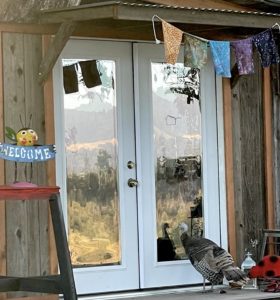
Turkey reflecting…
Thanksgiving has been positioned by America’s promotional wizards as “Turkey Day” because gratitude is harder to monetize than dead fowl. I appreciate Thanksgiving because, besides being a moment to gather for a meal with friends and family, it also marks the end of the year’s growing season on the farm and I know that I’ll have a couple of more restful months ahead of me before the merry-go-round speeds up again. We’re almost to Thanksgiving again and I’m thankful that we’ve had a year on the farm with lots of work, but no accidents or unseemly drama. It’s been another weird year’s ride through the Covid pandemic, with uncertainties abounding, but thanks to your support we’ve made it through the season, and we’ve got a fall harvest basket full of wonder to share with you for your Thanksgiving meal. We wish you a peaceful Thanksgiving.
Here’s our schedule:
Following Thanksgiving we will step away from our regular delivery schedule but we will do some December pop-ups as we approach the winter holidays. Here’s our tentative schedule for December.
Saturday, December 10, 2022 in Palo Alto
Thursday, December 15, 2022 in Berkeley
Saturday, December 17, 2022 at Piccino Restaurant in SF.
Tuesday, December 20, 2022 in Santa Cruz County and Los Gatos
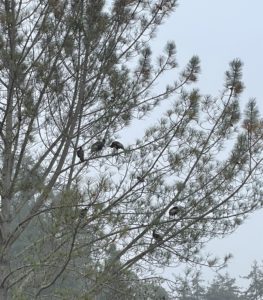
Turkeys roosting…
The holidays are here and we hope that you will consider sharing our gift boxes of dried herbs and herbal infusions, heirloom beans and jarred beets, curried cauliflower, tomato juice, crushed tomatoes and marmalades with your friends and and family. We ship or we will drop off at a pickup location. We also have lots of lavender, rose petals and lavender florets to share before the year is over.
Thanks for support this year!
Your friends at Mariquita Farm!
Andy, Starr, Shelley, Kelly, Gayle, Gildardo, Rebeca, Fidel and Federico, Hose, Abisai, Claudia, Neftali, Ramone and Maria
© 2022 Essay and Photos by Andy Griffin
Chayote
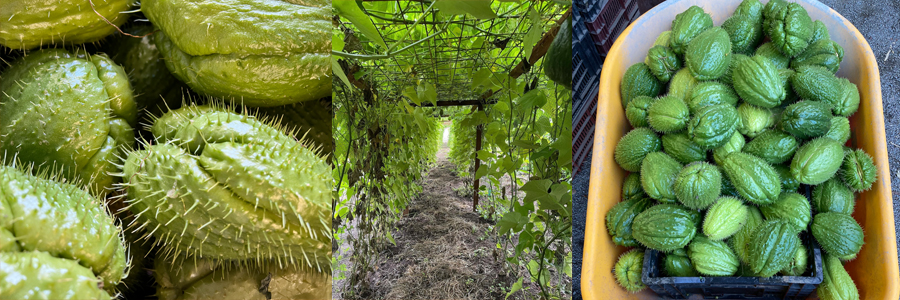
A few of you might find the fierce looking chayote that I’ve put in your harvest share box to be somewhat alarming. Fear not! Beneath it’s seemingly hostile exterior the chayote is actually a mild-mannered, healthy, economical and tasty friend in the kitchen with a worldwide fan-base. In case you don’t already know the chayote plant by reputation or from personal experience, let me make a formal introduction:
Every plant’s leaf is essentially a solar panel, erected and unfolded with the express purpose of gathering the sun’s energy in order to power the growth, maintenance, and eventual reproduction of the organism. The chayote’s broad, flat, and soft, pliable leaf is a clue that it might be a fast growing plant, and indeed it is. Not only do broad, flat leaves capture lots of sunshine and provide the power for rapid growth in high light environments, they’re also useful for plants that are growing in lower light situations to capture any and all of the available photons, and we see that the chayote employs both strategies for survival. Chayotes evolved in the area we now know as Central America, especially southern Mexico, Guatemala, and Honduras. The Chayote is a sprawling creature, spreading out over any available ground while sending long, tendriled vines high into and through the canopy of nearby trees, emerging from the tangled branches that make up the roof of the jungle into the bright light just that much closer to the sun.
If leaves are “solar panels,” then tubers are “batteries.” A chayote vine may trail 50 feet up a tree to chase the sun but it is sending the energy it gathers down the tangle of its stems into a tuber buried under the ground. The tuber stores the sun’s energy in the form of sugar and starch. A tuberous growth habit is a typical survival mechanism for tropical plants that can experience sudden, unexpected frosts that will burn up tender, exposed foliage. Yes, the Central American ecosystem where chayote evolved is usually warm, humid, and sunny, but mountains are mountains, and every once in a while there’s a sudden, hard frost that stings the higher elevations. The chayote that gets burned to the ground by the cold can always stage a comeback by sending up new shoots from the buried tuber that was insulated by the protective embrace of the earth. Potatoes do this too; they’re from the tropical Andes where the inconsistency of the weather is the only “constant.”
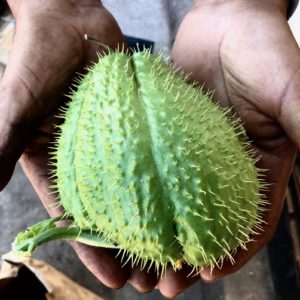
Oaxacan Chayote
A wild chayote’s fruit is spiny, which tells us that there’s something tasty there to be protected. The chayote is in the squash family, the Cucurbitaceae, and the flesh of its fruit is dense and mild flavored. A mouse or wild boar might want to eat the chayote but the gourd’s stiff spines are not very inviting. The indigenous people who lived across the natural range of the chayote learned to peel the spines off and enjoy the flesh of the fruit either raw, sliced thin and made tender with lime juice or salt, or steamed, boiled, baked or grilled.Like its cousin, the zucchini, the chayote has a mild flavor that can serve as a “delivery vehicle” for any number of more emphatic and unctuous sauces like mole. Our modern name for the crop, “Chayote,” comes from the Nahuatle word, “chayotli,” but as the crop gained popularity and spread south into what’s now South America it picked up other names, like “Chuchu,” or “Cahiote.” The fruits were harvested and used like squash, the tendrils and leaves were used as greens and added to soups and stews, and the tubers were dug up and cooked like potatoes.
When the Spanish voyagers came to the “New World” the chayotes jumped aboard their sailing boats. Despite its many uses, the chayote was not initially welcomed back in Europe. Like other indigenous American crops that feature in the “Columbian Exchange,” like the potatoes, tomatoes, and chili peppers, the chayote was suspect because it was not mentioned in the Bible. Since it didn’t get a specific name drop in Genesis, doesn’t that mean that the chayote might not have been created by God, but rather by Satan?
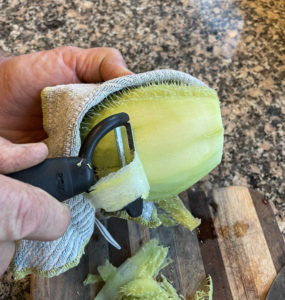 Once their colonies were established the Spaniards gathered up once a year, the immense piles of silver, gold, and jewels that they robbed from their new American subjects, or dug with slave labor from American mines and loaded up their ships with the booty, setting sail for Asian ports where they would trade. The treasure fleet that left from the port of San Blas, in Nyarit, was called the Manila Galleon, because its first port of call was in the Philippines. Filipino cooks were unconcerned with chayote’s suspected Satanic origins and they took to crop fast. Tagalog for chayote is “Sayote.” From Manila the culture and appreciation of the chayote spread out across Asia. You know that little chunk of something white and unknown that was covered in sauce in your Chinese takeout and you ate it without worrying? Chances are strong that was chayote.
Once their colonies were established the Spaniards gathered up once a year, the immense piles of silver, gold, and jewels that they robbed from their new American subjects, or dug with slave labor from American mines and loaded up their ships with the booty, setting sail for Asian ports where they would trade. The treasure fleet that left from the port of San Blas, in Nyarit, was called the Manila Galleon, because its first port of call was in the Philippines. Filipino cooks were unconcerned with chayote’s suspected Satanic origins and they took to crop fast. Tagalog for chayote is “Sayote.” From Manila the culture and appreciation of the chayote spread out across Asia. You know that little chunk of something white and unknown that was covered in sauce in your Chinese takeout and you ate it without worrying? Chances are strong that was chayote.
I’ve started growing chayote under the influence of my foreman, Fidel, and the Oaxacans I’ve been working with. It’s been a fun crop to learn about. The trick for success in growing any plant is to learn where and under what conditions it evolved, and to mimic that setting as much as possible. If a plant germinates and feels “at home,” the chances are very high that it will grow successfully. We bury each chayote that we intend to grow in a gopher basket so that the pesky rodents can’t harvest before we do. We erect a frame of 4×4 posts cloaked in chicken wire to give the vines something to climb on, like the thickets of sticks that natural chayotes would encounter in a natural setting, and then we give the plantation a thorough, gentle soak every once in a while, just like the rains they would experience in their Oaxacan or Honduran mountain homes. The chayote plants seem very happy here.
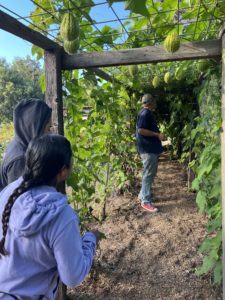 I had a couple of Oaxacan women visit the farm the other day and do a chayote “U-Pick.” They prefer the spiny chayotes, which is the variety that they know from back home. We have several different kinds of chayote growing, including the smooth forms that are preferred in Asian markets. What I’ve noticed is that the spiny chayotes come first, and the spineless, smooth chayotes tend to take a couple of weeks longer to develop, even though they were all planted at the same time. Maybe I’m just dull and insensitive, but the several kinds all taste pretty much the same.
I had a couple of Oaxacan women visit the farm the other day and do a chayote “U-Pick.” They prefer the spiny chayotes, which is the variety that they know from back home. We have several different kinds of chayote growing, including the smooth forms that are preferred in Asian markets. What I’ve noticed is that the spiny chayotes come first, and the spineless, smooth chayotes tend to take a couple of weeks longer to develop, even though they were all planted at the same time. Maybe I’m just dull and insensitive, but the several kinds all taste pretty much the same.
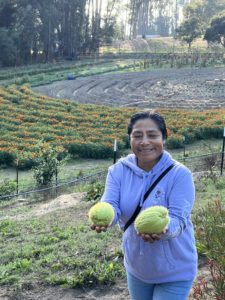 I hope you enjoy eating the chayote as much as I have enjoyed growing them. You can use them almost anyway you would any other summer squash. I’ve enjoyed them in saute and dressed with lemon or lime juice. You can keep them in the fridge, but you don’t need to. They’re perfectly able to hang out at room temperature on the counter and you can enjoy them as weird vegetal sculptures before you cook them.
I hope you enjoy eating the chayote as much as I have enjoyed growing them. You can use them almost anyway you would any other summer squash. I’ve enjoyed them in saute and dressed with lemon or lime juice. You can keep them in the fridge, but you don’t need to. They’re perfectly able to hang out at room temperature on the counter and you can enjoy them as weird vegetal sculptures before you cook them.
Andy and the Crew at Mariquita Farm
© 2022 Essay by Andy Griffin
Photos by Andy Griffin and Starling Linden
Something to Crow About
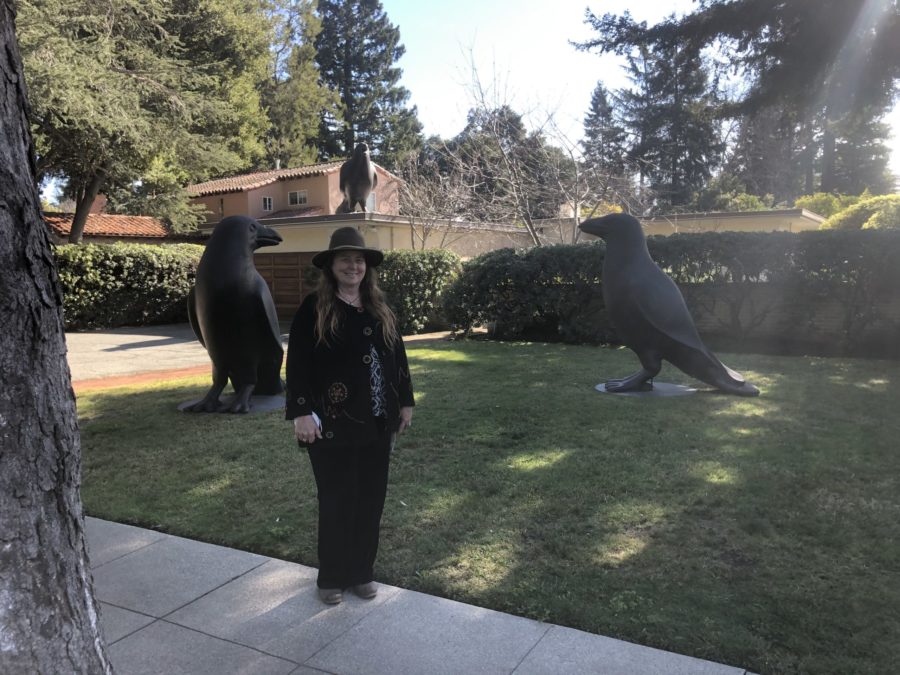
Starr with a few crows in Palo Alto.
I’m booted up, caffeinated, mouse in hand, and ready to hammer out a petulant screed concerning the general carelessness in the fashion industry as concerns “seasonality.” But first, we need to address some scurrilous allegations and imputations that have been passed around about the genus Corvus.
Cattle form a “herd.” Bees “swarm.” “Geese flock.” Even Alligators only “congregate.” But when three or more crows gather together it’s a “Murder?” This terminology isn’t fair to crows. Yes, some crows can be naughty. And maybe crows poke their beaks into places they’ve not been invited, but Corvus family members are not straight-up killers like the hawks and eagles of the Falconidae. Maybe it’s because of their curiosity and willingness to go where they don’t belong that Crows, Magpies, and their cousins, the Ravens, ended up serving the mythic world as “spies for Odin,” and “messengers” for other Norse gods. Crows worked for Yahweh too; when Noah wanted to see if the world flood that God had let loose was receding, he let loose the raven to fly over the waters the way a modern day General might send forth a drone. Of course, Noah’s raven didn’t come back. Religious scholars may differ on why a free bird didn’t return to the fetid, crowded ship full of bawling, mooing, barking, howling, braying, hissing creatures, but suffice it to say that the Corvus family doesn’t need humankind to survive. After the glow of our man-made Apocalypse has faded, and the radioactive ashes have settled, the crows will still be here, along with the seagulls, cockroaches, coyotes, and raccoons. Corvids are smart birds.
I’ve seen the damage crows can cause but their crime was greed and not malice, the way a murder is. In the early 1980s, when I worked at Star Route Farm, in Bolinas, we planted out the lagoon field in pumpkins and gave the land a light sprinkling. We were confident that once the pumpkin seeds germinated their roots would soon penetrate the rich soil and reach the abundant groundwater. We speculated that we’d be able to essentially dry-farm the pumpkin patch to a successful harvest. The pumpkins germinated. As each seed sent down the radical, or first root, into the soil, the two fat, green cotyledons of the sprout pushed out of the soil into the sunlight, still wearing the now empty husk of the pumpkin seeds like little hats. A “murder” of crows passed by and saw the fresh sprouts. They wanted to fatten up on some tasty, rich pumpkin seeds so they tugged at the husk. The crows succeeded in pulling the tiny plants from the ground but each sprout was a disappointment because the oily seeds had burned up all their nutritious oil and rich flavor. The crows hopped from sprout to sprout, tugging at the seed husks until the entire crop was uprooted. The day after the crop germinated the field was bald of any pumpkin spots. Luckily, it was early enough in the season so that we could re-plant the crop. When we set out the second crop of pumpkins we used transplants instead of directly sowing the seeds, and we carefully pulled any seed husks that still clung to the cotyledons before we popped the little plants in the soil. And we put out scarecrows.
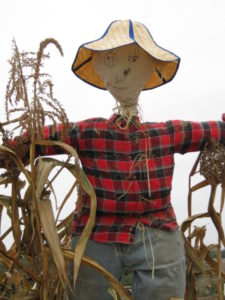 It’s not clear to me that scarecrows actually “scare” any crows, but putting them in the field like sentries does help a farmer feel like they’re doing everything they can to produce a good crop. Once the early, cold, hungry months of spring are past, there’s generally enough food around for crows to survive without worrying a garden to death. Crows are opportunistic; they’ll eat bugs, worms, insect eggs, seeds, and carrion. They’re like coyotes in that respect, always on the lookout for an opportunity. But crows are not malevolent by nature; they just fulfill a niche that awards them for being nosy, indelicate, and persistent. And, like the coyote, crows can be loud. To call a group of crows a “murder,” is to devalue the role they play in a healthy, balanced natural ecology. I suggest that we “re-brand” the crows that flock together as a “caw-cawphony” of Corvids.
It’s not clear to me that scarecrows actually “scare” any crows, but putting them in the field like sentries does help a farmer feel like they’re doing everything they can to produce a good crop. Once the early, cold, hungry months of spring are past, there’s generally enough food around for crows to survive without worrying a garden to death. Crows are opportunistic; they’ll eat bugs, worms, insect eggs, seeds, and carrion. They’re like coyotes in that respect, always on the lookout for an opportunity. But crows are not malevolent by nature; they just fulfill a niche that awards them for being nosy, indelicate, and persistent. And, like the coyote, crows can be loud. To call a group of crows a “murder,” is to devalue the role they play in a healthy, balanced natural ecology. I suggest that we “re-brand” the crows that flock together as a “caw-cawphony” of Corvids.
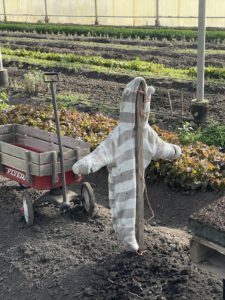 I also call upon the fashion industry to rethink their tired efforts at dressing our nation’s scare crows as a gesture of respect for nature. Why, if the point of putting a scarecrow into a field is to scare off the crows from the recently sprouted crops in the spring, or from the first ripe berries and fruits of the early summer, are scare crows only given attention in the fashion press in the fall? And why are the scare crows so typically draped in dreary rags? The crows that these scarecrows are supposed to be scaring always look their best in shiny, iridescent, black plumage. Maybe the designers that plot the fall fashion lines for scarecrows want the crows to actually die laughing at the hideous overalls and straw hats that the scarecrows must typically wear. Wouldn’t it be more fun and effective to dress the scarecrows in the neon outfits that bicyclists favor? Or how about those insane golf pants that old guys wear on the links- those are scary as hell….Wedding dresses could be repurposed for scarecrows too, once the lifetime union of two souls has been torn asunder by infidelity or dishonesty and the dress simply hangs in the closet as a reminder of disappointment. Crows aren’t use to seeing these kinds of garments on the scarecrows and maybe they would find the novelty of new outfits alarming. Each winter the fashion world could have their models walk the runways festooned in the newest, most lurid and alarming styles that will soon be seen in the nation’s gardens and farms.
I also call upon the fashion industry to rethink their tired efforts at dressing our nation’s scare crows as a gesture of respect for nature. Why, if the point of putting a scarecrow into a field is to scare off the crows from the recently sprouted crops in the spring, or from the first ripe berries and fruits of the early summer, are scare crows only given attention in the fashion press in the fall? And why are the scare crows so typically draped in dreary rags? The crows that these scarecrows are supposed to be scaring always look their best in shiny, iridescent, black plumage. Maybe the designers that plot the fall fashion lines for scarecrows want the crows to actually die laughing at the hideous overalls and straw hats that the scarecrows must typically wear. Wouldn’t it be more fun and effective to dress the scarecrows in the neon outfits that bicyclists favor? Or how about those insane golf pants that old guys wear on the links- those are scary as hell….Wedding dresses could be repurposed for scarecrows too, once the lifetime union of two souls has been torn asunder by infidelity or dishonesty and the dress simply hangs in the closet as a reminder of disappointment. Crows aren’t use to seeing these kinds of garments on the scarecrows and maybe they would find the novelty of new outfits alarming. Each winter the fashion world could have their models walk the runways festooned in the newest, most lurid and alarming styles that will soon be seen in the nation’s gardens and farms.
Andy and the Crew at Mariquita Farm
© 2022 Essay and Photos by Andy Griffin
And, something to crow about…check out this article in Edible Monterey Bay, “Cactus, Citrus and Cauldrons at Mariquita Farm” by Laura Ness.
A Wise Recipe
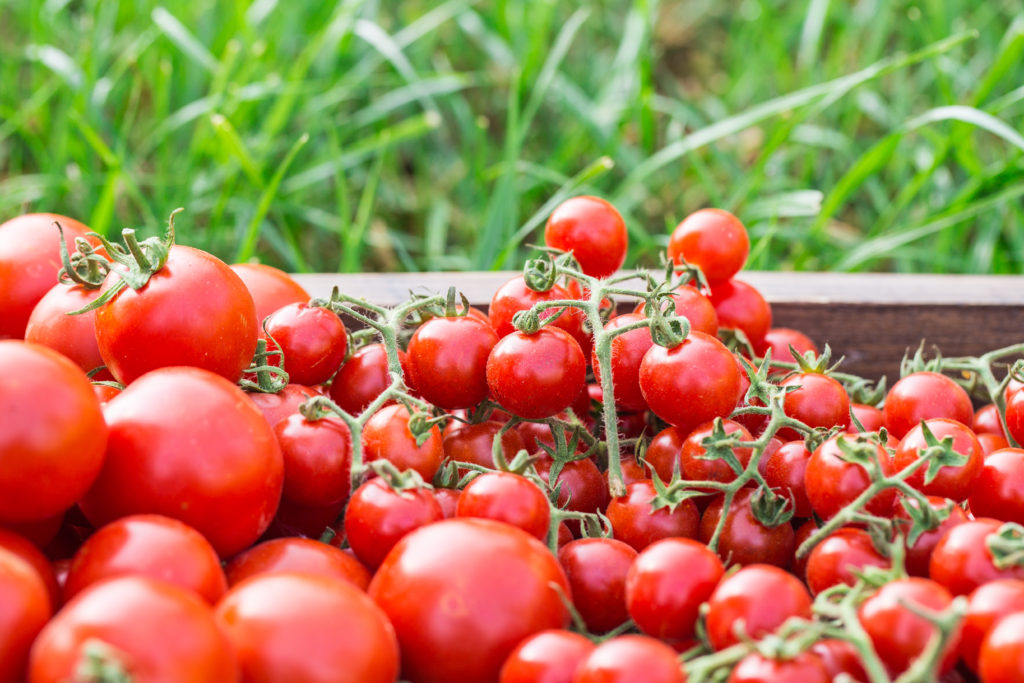
Ripe fruit from the vine!
Joel is my “cousin in law” from the Midwestern side of my family. He’s a gifted artist who works in a number of different mediums, and I really appreciate the decorative tile work that he did for us that we have set in the walls of our kitchen; one tile showing a carrot, another a green onion. Joel lives in rural Minnesota and I am pretty much pinned down to my plot of ground here on the left coast, but I follow his progress on social media. Sometimes, besides posting photos or updates about his artwork or family he will re-post memes of a social or political nature, and I am usually amused by them or share the sentiment that they seek to convey. But sometimes Joel will take his taste for socialist inspired messages entirely too far. Recently he posted a meme about the differences between knowledge, wisdom and philosophy that really grated on me and I thought I might reach out and contact him personally, but then I decided that since these distinctions are important and affect us all I would address all of you with my concerns and cc Joel. The offending meme runs as follows:
“Knowledge is knowing that a tomato is a fruit.
Wisdom is not putting it in a fruit salad.
Philosophy is wondering if putting it in a Bloody Mary counts as a smoothie.”
WRONG, WRONG, WRONG!. I’m a tomato farmer, so I have a dog in this fight. Plus, once-upon-a-time in a previous life I got a degree in Western Philosophy. True, a philosophy degree does not convey any privileged insights into the value or meaning of ultimate reality, but if a student pays attention in class and reads the material they’ve been assigned they can learn how to act as though they have witnessed the mysteries revealed. I did my homework, so I feel confident “laying it on thick,” and here’s what I know about truth, knowledge, wisdom and tomatoes.
It’s true that the tomato is a fruit. If you have a hard time with that fact then you probably won’t accept that the palm tree is a grass or that the pumpkin is a berry, or that climate change is real. In that case, this essay isn’t for you.
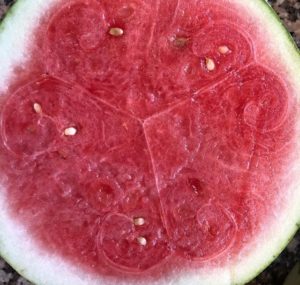 It’s not true that “Wisdom is NOT putting a tomato in a fruit salad,” At one time in life I would have agreed with that sentiment, but time and experience have taught me that the tomato can be a fantastic component in a fruit salad, and that having “wisdom” is having the willingness to learn from experience and accept facts as real, even when they contradict dearly held prejudices. Opening oneself up to the potential validity of tomatoes in a fruit salad can be an example of living philosophically. Better yet, MAKE a fruit salad with tomatoes and learn. The Spanish language can be revealing in this instance. In Spanish the verb “saber,” meaning “to know,” is the same word as the verb “to taste.” The word “savory” in English is cognate with “saber” in Spanish. The old frontier/cowboy expression- “you savvy?” is a degraded, anglicized version of the Spanish phrase “Sabe Usted?” meaning, “do you get it?” Fruit salad can be savory, as well as cloyingly sweet. Here’s a recipe for a savory fruit salad that celebrates the tomato as a fruit.
It’s not true that “Wisdom is NOT putting a tomato in a fruit salad,” At one time in life I would have agreed with that sentiment, but time and experience have taught me that the tomato can be a fantastic component in a fruit salad, and that having “wisdom” is having the willingness to learn from experience and accept facts as real, even when they contradict dearly held prejudices. Opening oneself up to the potential validity of tomatoes in a fruit salad can be an example of living philosophically. Better yet, MAKE a fruit salad with tomatoes and learn. The Spanish language can be revealing in this instance. In Spanish the verb “saber,” meaning “to know,” is the same word as the verb “to taste.” The word “savory” in English is cognate with “saber” in Spanish. The old frontier/cowboy expression- “you savvy?” is a degraded, anglicized version of the Spanish phrase “Sabe Usted?” meaning, “do you get it?” Fruit salad can be savory, as well as cloyingly sweet. Here’s a recipe for a savory fruit salad that celebrates the tomato as a fruit.
1: Split open a watermelon and cut the flesh into bite-sized cubes and dump them in a large bowl.
2. Lightly salt the watermelon cubes. I use our Mariquita herb salt to give the salad some extra kick.
3. Slice up a bunch of tomatoes and toss them in with the watermelon.
4. Mince up a red onion and stir that in too.
5. Juice several limes or lemons and pour the juice in with the fruit.
6. Chop up several cucumbers too and add them.
7. Drizzle in some olive oil to taste and stir it around,
8. Cube up some Feta cheese and mix that in too.
9. Taste the juice that has collected in the bowl as the salt and citrus juice provokes the tomatoes melons and cucumbers release liquid and adjust for flavor, If the juice is too bland add more lime juice.
10. Chill the watermelon/tomato fruit salad and serve. Your guests will agree you are a smart cook and if they’re wise they’ll be able to make this salad themselves in the privacy of their own homes.
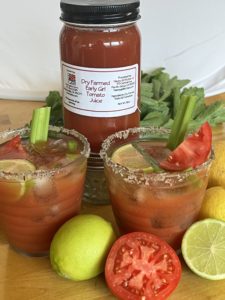
Dry Farmed Early Girl juice Bloody Marys!
Oh…. and yeah, the Bloody Mary is a smoothie. And we have jars of delicious Dry Farmed Early Girl Tomato Juice for sale on our website. Don’t miss it, it really is the Platonic Ideal of tomato juices.
Enjoy!
Andy and the Crew at Mariquita Farm
© 2022 Essay by Andy Griffin
Photos by Andy Griffin and Starling Linden
Tomato Season
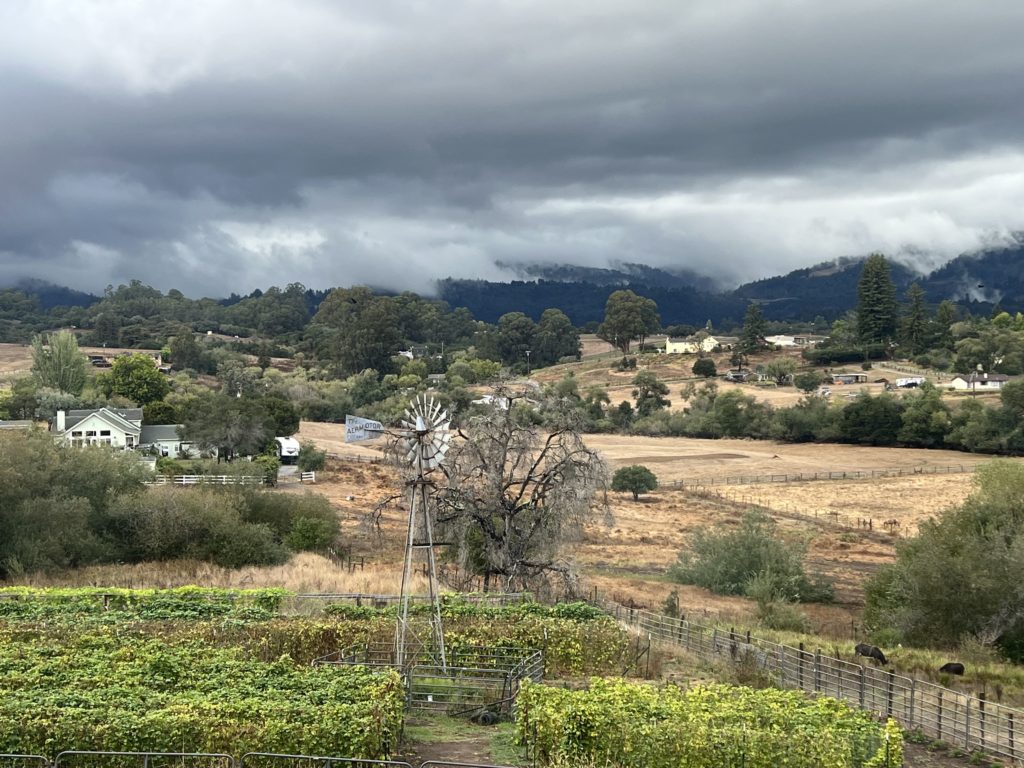
As I sit down to write this note to you I can hear the rain hitting the roof. This is as early in the season as I can ever remember of us getting a meaningful amount of rain, so the question on everybody’s mind is, “How long into the fall do you think we’ll have tomatoes?”
If I could answer that question accurately, reliably, and consistently, I’d be a billionaire-shaman figure, not a puzzled dirt farmer.
I CAN tell you when we will plant the tomatoes; it’s always on April 15th, give or take a few days. By April 15th the danger of frost will have largely passed and the soil will have warmed enough to welcome tomato plants. Often, we will see tiny tomato weeds born from the seeds of last years’ ground fall fruit sprout on their own around this time of year. After we plant the first crop, we will usually follow up with several sequential plantings so that we can enjoy a harvest spread out of the whole season.
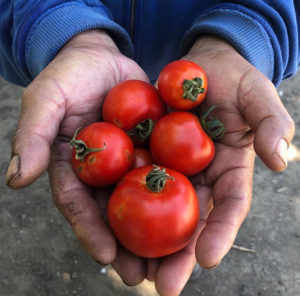
Dry Farmed Early Girl Tomatoes
I can tell you when we’re likely to have our first fruit of the season. True, the weather being relatively cooler or hotter can push the date of the first harvest or retard it, but we always see the cherries first in late June, we see the first Early Girls in mid-July, as well as the first Heirlooms. By late August we see the San Marzanos. All of these crops are “indeterminate,” meaning that they can continue to flower and fruit over a long season. Tomatoes are tropical in origin, having first evolved as a food crop in Ecuador around 7,000 years ago. As long as the weather stays “tropical,” the tomatoes stay happy, but they succumb quickly to the elements when conditions become cold, damp, and wet. We have a tomato plant in our greenhouse that is several years old and at least 10 feet high, because the nighttime lows in the greenhouse never drop into the 30s.
We count on having good conditions for tomato production from April thru October. Sometimes a late frost or an early rain will set the crop back or stall it out early. I remember an April 16th frost that zapped our planting pretty badly, but the roots and stems survived and re-sprouted and it turned out to be an ok year. And one year we had a pretty major rainstorm on October 3rd. Later in the season, when the nights are longer and there’s less time for the plants to dry out, a drenching rain can give rise to leaf rot in the middle of the dense canopy of foliage, and the tomatoes will soon sicken and die.
A rain that falls earlier in the year, like the one we are experiencing right now, may not have a lethal consequence. If the days are still long enough or breezy enough for a tomato plant to dry out promptly a rain can be a good thing. Pest mites like the Two Spotted mite that happily chew on tomato plants thrive in dry, dusty conditions. Clean and humid environments favor their enemy, the Persimilis mite, which feeds on the Two Spotted mite. A quick, cleansing rain can encourage the beneficial, predatory mites, even as it discourages their prey.
If this year’s crop is not adversely affected by this passing rainstorm, then I’ll hope that we will be able to harvest thru October, and maybe even into November. As October deepens, anything can happen. And if the bounty is grand then we might even see a tomato on the Thanksgiving table, which can be a real joy.

Dry Farmed Early Girl juice Bloody Marys!
If you aren’t a canner and you want to enjoy the Dry Farm Early Girls into the winter we have a limited supply — which is going fast — of already canned crushed dry farmed early girl tomatoes. And because one never knows, you should get your boxes and jars of tomatoes today! The Dry Farmed Early Girl Tomato Juice is also the perfect choice for the end of summer Gazpacho soup or a Bloody Mary during brunch next weekend.
Enjoy!
Andy and the Crew at Mariquita Farm
© 2022 Essay by Andy Griffin
Photos by Andy Griffin and Starling Linden
Striking Gold
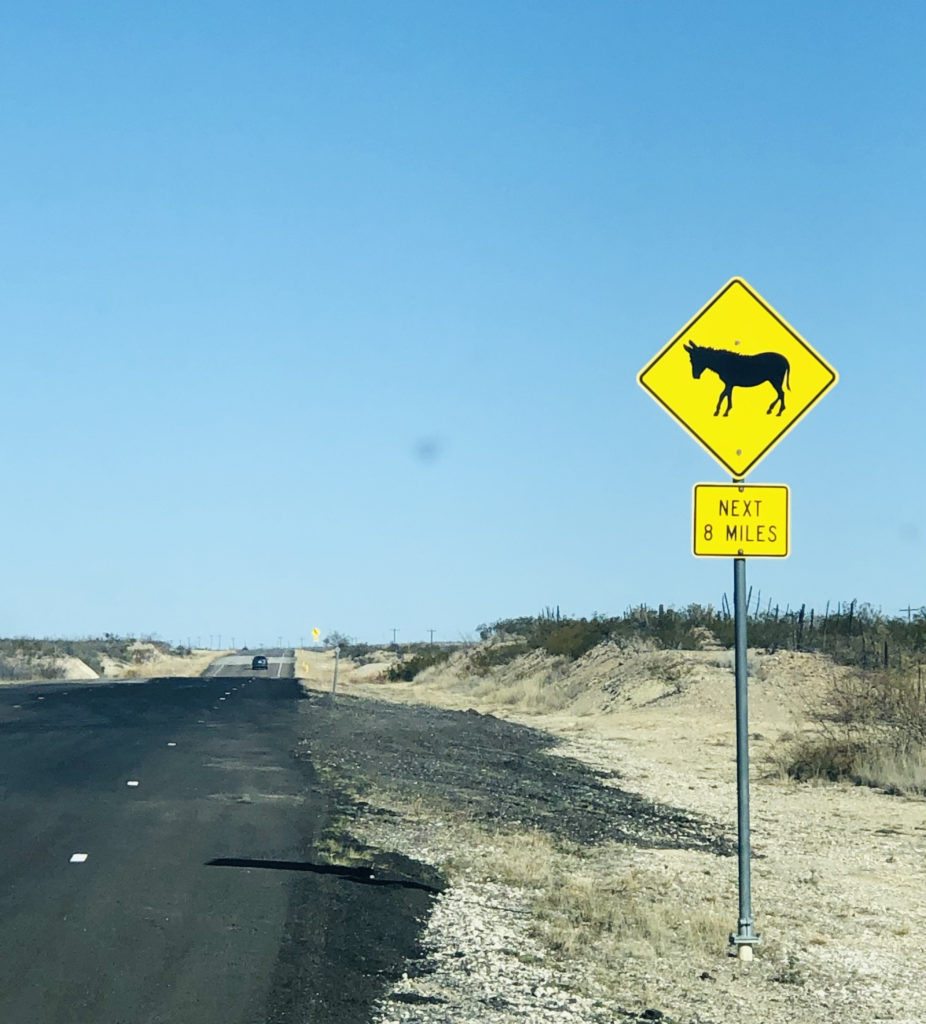
“Give me two reasons why anybody would want to live in Texas,” I said to cousin Weldon. I was probably nine at the time and I’d only passed through the Lone Star State once on a cross-country trip my family had taken three years before in the summer of 1966. We had a Volkswagon bus, and I’d been stuck in the back seat, sweltering, so I wouldn’t bug my sister, for the last 1,500 miles. Looking out the window of that VW, Texas had looked to me a whole lot like Bakersfield CA, except that it was a whole lot bigger- indeed, it seemed to go on forever. I wasn’t in love with it. But Weldon was, having had the good fortune to have been born there, and at 12 years of age, he had the maturity and confidence to answer me boldly and unequivocally.

Drive up window for a liquor store somewhere in Texas.
“Dallas Cowboys, Houston Oilers,” Weldon said, without a moment’s hesitation, before reciting the litany of Texas’s endless charms and marvels; the coldest beer, the hottest women etc. etc. And while I’ve remained amused by the average Texan’s oversized pride of place, even into adulthood, I’ve gained a more nuanced appreciation for Texas. Bottom line; despite the state’s insane politics, Texas really IS big, and it’s big enough to embrace a kaleidoscope of characters that defies any attempt to simplify or pigeonhole it. There’s Willie, of course, who I think is a truly great American, but there are a growing number of my own family members there, and I’ve had an opportunity to make some friends there over the course of a number of trips. Last winter, Starr and I passed through “miles and miles of Texas” on our way to visit my cousin, Elizabeth, in Houston, and we had an opportunity to visit my friends, the Arnoskys, at their flower farm near Blanco, up in the Hill Country.
I met Pamela and Frank Arnosky years ago at the Texas Organic Farmers and Gardeners Convention, that was held that year down on South Padre Island on the gulf coast. Later, after a subsequent conference held up in Kerrville in the Hill Country, I had an opportunity to visit their farm. No farmer anywhere would ever suggest that the interior of Texas is the easiest place in the world to grow organic cut flowers, but they’ve done a magnificent job. I could write a whole essay about how systematically and generously they’ve gone about the task of growing flowers and the mission of creating community, but today I want to talk about just one flower; the marigold.
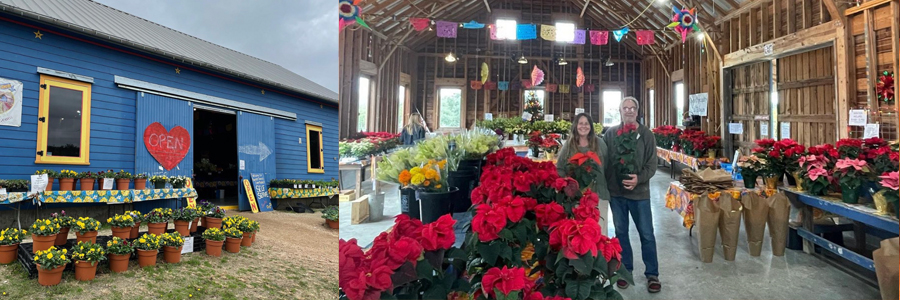
Andy and Starr inside the Big Blue Barn at the Arnosky’s Flower Farm.
Frank and Pamela are not just good growers- they’re very thoughtful and innovative about marketing. They’d always grown marigolds and over time they developed a reputation for having beautiful, clean, sturdy, and affordable marigolds at exactly the right time for the Dia de Los Muertos celebrations that are a yearly tradition in the Hispanic community. The Arnosky’s flower farm is out in the boonies, but it’s more or less equidistant between San Antonio and Austin. So it wasn’t too long before the Southern Asian communities that have sprung up around Austin found out about them and began arriving in the fall to get their marigolds for Diwalli, the festival of lights.
When farmers get together we usually seize the moment to bitch and moan about the weather, the prices, the regulations, the cost of fuel, packaging and labor, but we will usually trade tips on what crops have been working. As we listened to Frank and Pamela talk about their experiences growing marigolds it occurred to Starr and I that we ought to give the flower a try. Our farm is in the middle of a very vibrant Hispanic community and there are large populations of South East Asians nearby and, besides, who doesn’t think marigolds aren’t beautiful. Plus, from an organic perspective, marigolds make a good rotation crop, since their roots create natural chemicals that tend to depress the populations of pathogenic nematodes.
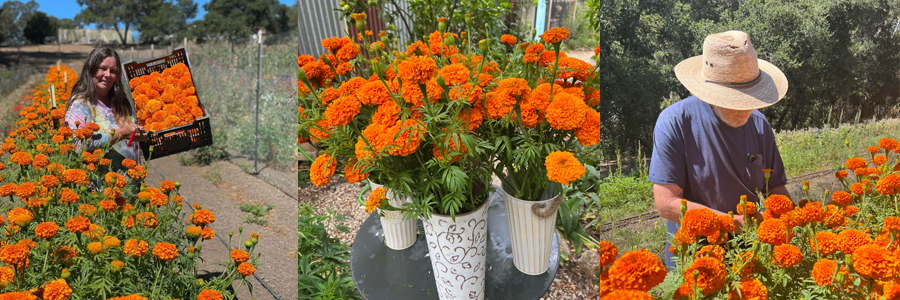
There are any number of marigold varieties available, but Frank hooked me up with a seed company out of Thailand that has the best marigolds for sacramental purposes. The type I chose to grow- which he recommended- is called Chedi, and the orange color is exactly the hue of the orange robes you’ll see Vietnamese Buddhist monks wearing. He also gave me suggestions for the best dates to drop seed in order to make the Diwalli/Dia de los Muertos harvest a bullseye. Conversations our foreman, Fidel, had with local Oaxacan growers confirmed the dates that work best at this latitude and we made plans. But because I’d never grown Chedi before, I planted a series of small crops to have an opportunity to learn the crop. I ended up learning a whole lot more.
Our friend, Jordan, who owns and operates Happy Girl Kitchen in Pacific Grove, came by the farm to pick up a quantity of dry farmed early girls to can and she saw one of my experimental rows of marigolds. She was stoked. I didn’t know it, but one of my test plantings of Chedi was blooming just in time for two important celebrations; Balarm’s Presentation, and Krishna’s Birthday. She asked to get a large quantity of blooms for the temple she’s a member of up in Mountain View. It was a lot of fun getting all the blooms picked, and she sent us some great pictures of the garlands that the people in the temple created.
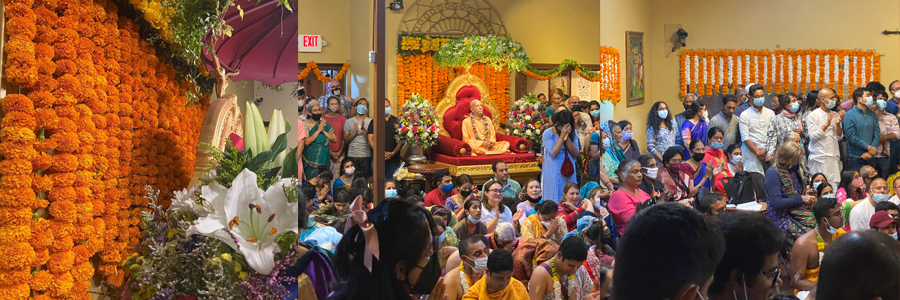
If you want to check out the farm in early October, come on out to see a handful of farms on the central coast, ours included, during the Open Farm Tours on October 8th.
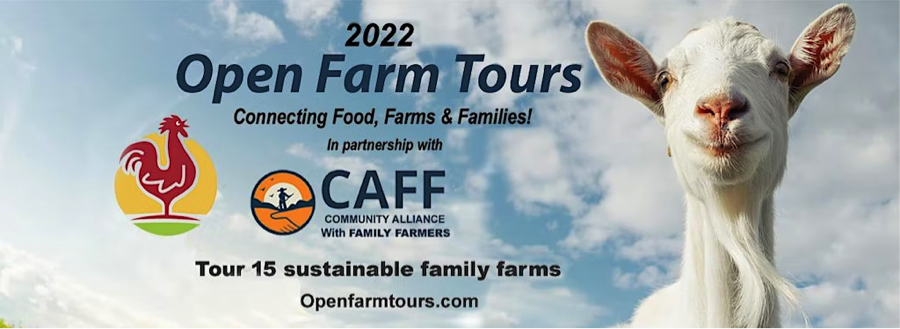
Thanks again for all your support!
Andy and the Crew at Mariquita Farm
© 2022 Essay by Andy Griffin
Photos of locations in Texas and of Starr harvesting Marigolds at Mariquita by Andy Griffin.
Photos of Marigolds and Andy harvesting them by Starling Linden.
Photos of Marigolds at Temple by Jordan Champagne.
Step Right Up!
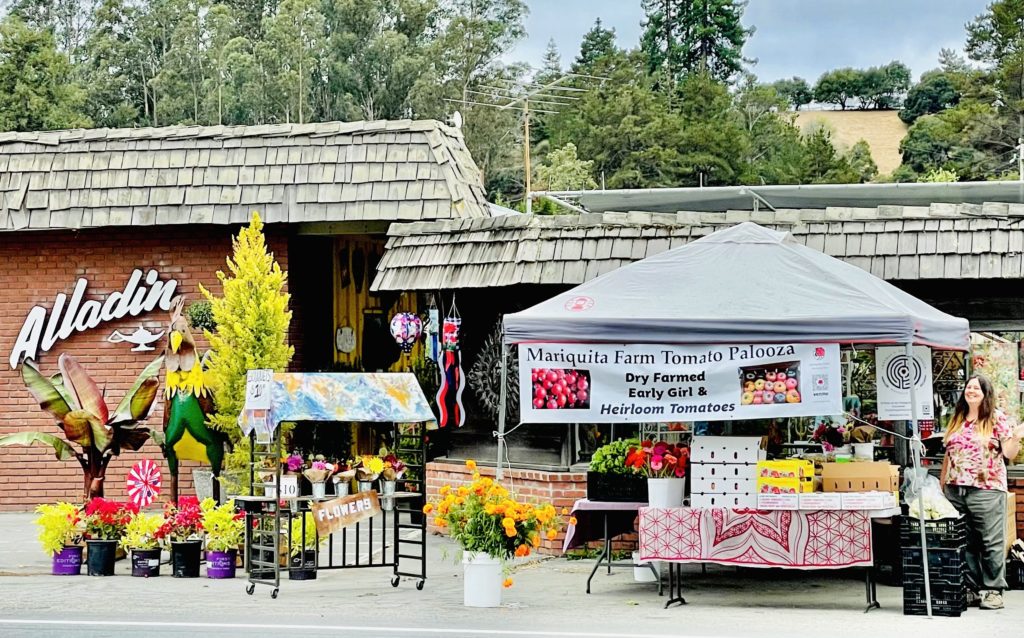
Our first Tomatopalooza of the season at Alladin Nursery in Watsonville.
A “lollapalooza” is like a “humdinger” or a “doozy,” but different! And a “tomatopalooza” starts out as mild as a vegan humdinger, but soon rips and snorts like the bee’s knees. I jest, but not much. Here’s the lowdown:
Sometime back in the 1890’s the word, “lollapalooza,” was first recorded in print in the United States, and it meant something along the lines of “the best of its kind,” or “unusually impressive.” This “lollapalooza” rose up, dripping with excitement, out of our collective, cacophonic, verbal swamp, like a swaggering, bragging, carny barker of a monster. Nobody had patent rights to the “lollapalooza” and we have no such thing as an official “American Academy” that certifies the English vocabulary that’s fit to pronounce, the way that the French keep their language pure by following the rigorous dictates of their Academie Francaise. But purity isn’t much of a core American value, so nobody noticed, and everybody just used the word the way they felt like. Lollapalooza was not a word that Queen Victoria would have used, but its splendid vagueness served the likes of P.T. Barnum and, later, The Three Stooges. The noted American “inventor,” Rube Goldberg, named a cartoon character “Lala Palooza,” and at one point there was an exceptionally large lollipop marketed as a “Lollipalooza.” The Egyptians invented mathematics, the Greeks invented philosophy, and the Mexicans invented tomatoes, chilies, corn, beans, squash, cotton and chocolate, but we Americans invented a successful approach to mass marketing through hyperbole that blurs the fine lines between freedom, fantasy and fraud. Whatever else it is, the Lollapalooza is an American.
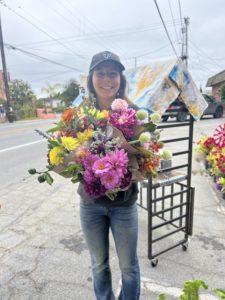
A Tomatopalooza customer with a bounty of flowers for a wedding shower.
In roughly contemporary times the word lollapalooza became associated with a touring rock music festival of the same name. I have not attended any of the Lollapalooza festivals, but it was maybe during one of those shows that I was not attending because I was always picking and hustling tomatoes that I decided to do our first “Tomatopalooza.” Like the musical Lollapalooza, the tomatopalooza is a forum for diverse performers, so instead of a lineup of acts that go from metal to punk to pop, you’ve got tomatoes of every genre performing, from tomatillos, little sweet 100s and sungolds, up through the larger dry farmed Piennolo, and Early Girls, all the way through to the big, fat heirlooms. Next to hit the stage will be the headlining act, the “San Marzanos”. And there are always the side shows like the jalapeños, basils and herbs that go so well with tomatoes. We found out that our customers like flowers as much as they like tomatoes. We did our first “Tomatopalooza” of the year this past weekend in front of Alladin Nursery in Watsonville and it was a success. Starr and I want to thank Gustavo and his family and staff for hosting our event. We met a lot of neighbors, saw a lot of friends, and sent a lot of tomatoes and flowers out into the world. If you are ever passing by Alladin you will see our flower cart out front, it isn’t easy to miss the brightly “ice-dyed” roof and the cart that is filled this time of year with Dahlias and Zinnias. And definitely take a look inside Alladin, it is filled with many wonderful plants and gifts that you can enjoy.
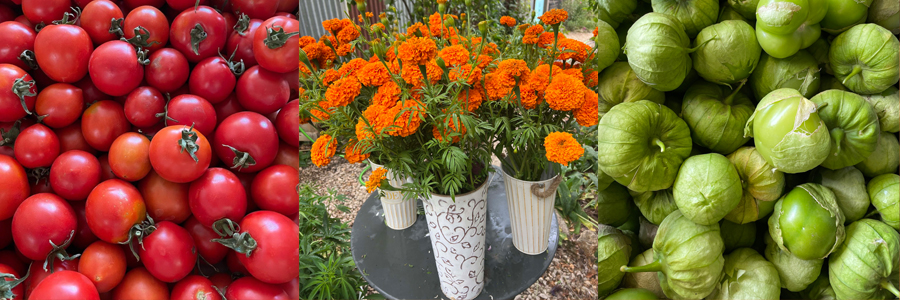
Dry Farmed Early Girl Tomatoes, Marigolds and Tomatillos
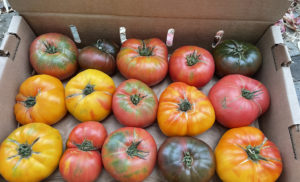
Heirloom Tomatoes
As Starr was helping people gather up their purchases and I was bringing more boxes from the van to the booth I found myself thinking about my grandfather, my mom’s father. He had a little country store up in Applegate, in the gold country, and I remember the state building I-80 right through “town”, dividing what was already a tiny village into two, separate scraps of community. My Grandpa’s store was in the same building as the post office, and library, and it was down the only block from the bar and the “‘no-tell Motel,” so it served as a casual community center. Grandpa sold worms for bait, Wonderbread, beer, pipe fittings, toys, toilet seats, guns, milk, eggs, ammo- anything and everything you’d need to satisfy the wants of a rural life. And in his parking lot he hosted the Applegate Community Center’s Community Garden Market. Just past the bar was an old, red, one-roomed schoolhouse that mom had attended when she was a girl, and that was the OFFICIAL community center. They had a large garden that people volunteered in and grew veggies for the market wagon. It was a great big buckboard style wagon with rubber tread wheels that they’d pile high with corn and okra and zucchini and…..tomatoes! My first job in the produce industry was sitting up on the wagon, bagging people’s green beans and sweet corn and melons and….tomatoes! The smell of tomatoes in the summer is, for me, the smell of summer.
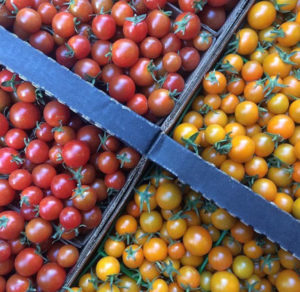
Sweet 100 and Sungold Cherry Tomatoes
Tomato season almost always starts around the same time of year, because we plant on or around April 15th, which is supposedly our average “frost free” date. But how long the season lasts is anybody’s guess; an extreme heatwave, like we had four years ago, or an unusually heavy and early rain, like we had six years ago, can bring things to an early end. In our dreams we have a steady flow of ripe fruit all the way until November, at which point we begin wishing it would please rain so that we know we will have the water for next year. Keep your eyes on the newsletter for a tomatopalooza near you. It’s “so far, so good” with this season, and it looks like we have a nice crop rolling in. Tomatopalooza 2022 is coming. I promise you it’ll be a rip-snorting humdinger.
Thanks again for all your support!
Andy and the Crew at Mariquita Farm
© 2022 Essay and photos by Andy Griffin
The Tale of the Tomatillo
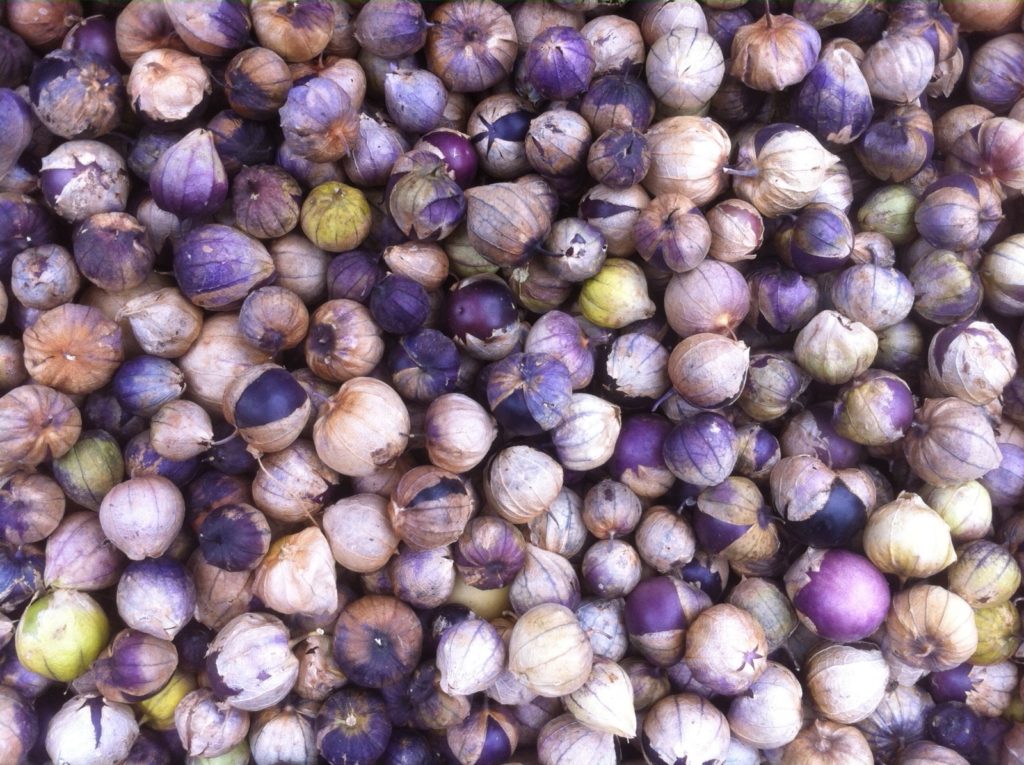
Tomatillo de Milpa
The Islas Marias are an archipelago in the Pacific some 60 miles offshore of Nayarit that have served as a Mexican Federal Prison Colony. I’ve never been there, but when we pick tomatillos I’m prompted to think back on Tia Maria “Pistolitas,” because her husband served a life sentence there, having been convicted of growing opium poppies and making black tar heroin back in Jalisco. “Pistolitas” means “little pistols,” and I’m not quite clear on how Maria first earned her name, but I remember her as somewhat of a firecracker by nature; a curandera, or natural healer, a defiant and outspoken lesbian grandma, a farmworker, as well as being a part time “coyote” who brought people across the border deserts ahead of every strawberry season. She was Ramiro’s auntie, or “Tia,” and I lived with Ramiro Campos and his family here for a couple of years back in the early ’90s. Besides Ramiro and his wife, Amparo, and their two children, I shared the house with his big sister, Maria. Ramiro’s uncle Raul and his wife, Maria, were frequent visitors to the ranch, as was Maria Pistolitas, his Tia from the other side of his family. Having one Maria go by the moniker “Pistolitas,” was helpful in keeping all the Marias sorted out.
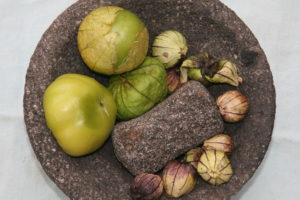
Tomatillos (Verde and Milpa) in a molcajete with a stone pestle, or ‘mano.’
Ramiro, Raul, Amparo, Maria, Maria, and I, were all sitting around the fire one evening in the yard, warming tortillas on a grill and sharing some beer and tacos. It was summer, so we had plenty of tomatoes, cebolla de rabo verde, or green-tailed onions, jalapeño peppers, and tomatillos. The women were making salsa by grilling the tomatillos, chilis and green onions over an open fire until they were slightly charred and softened by the heat, and then they’d mash it all together with a squeeze of lemon in their stone “molcajete” or mortar, using a stone “mano,” or pestle. With a lemon and limes hanging from the fruit trees growing not more that 20 yards from the fire, the smell of grilling jalapeños in the air, a handful of goats scandalizing just beyond the fence and peering through the woven wire fence at us, and with the Ranchero music playing low on the radio it was a very Mexican scene and a very pleasant evening. Ramiro was moved to philosophize: “You know, Andres,” he said. “This is really a paradise. We’re at the end of the road and the gate is closed, so we have all the privacy a person could want. With squash and garbanzo and corn and cilantro and chilis and corn growing in the garden, we’ve got almost everything we want.”
“What’s missing,” I asked?
“Tomatillo de Milpa,” Ramiro answered.
“These tomatillos are fine,” he said, gesturing to the big green tomatillos that were sizzling and popping on the grill. He and I both worked on Riverside Farms back then, and he’d brought the big, green tomatillos home from work where we had a big patch of them to harvest for our farmers market customers.
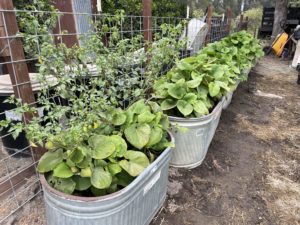
Tomatillo de milpa presenting itself as a weed in Andy’s young Hoja Santa hedge.
“But back home on our ranch in La Barca we’ve got the wild tomatillos growing all over the place. You don’t have to plant them, or water them, or anything; just send the kids out to pick them when they’re ready. They’re small, but they have less juice so they keep better, and the flavor is great, and they grill up well. The salsa is “mas autentica” con tomatillo de milpa.”
“Luckily,” he continued, “Mi Tia Pistolitas is coming up from La Barca next week to visit, and I’ve asked her to bring me a handful from the ranch so we can plant them here.”
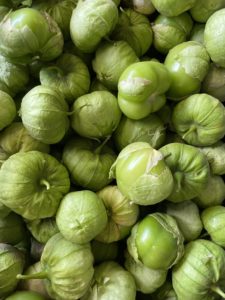
Toma Verde tomatillo, the cultivated form, big and green.
That was thirty years ago. Maria Pistolitas came to visit and she brought up a small paper bag with a handful of small, half-purple tomatillos de milpa for Ramiro to plant. The “milperos,” as they’re called, did great. Amparo and Maria harvested some of them, and the squirrels and crows and mice harvested some of them. Milperos don’t need a gardener’s attention to thrive; they just do their thing, and now we have milperos growing everywhere on the farm, whether we want them or not. I have a milpa, or corn patch, and of course the milperos have popped up there. But they’re also growing in the zinnias, they’re growing among the roses and lemons and cacti, and they’re even showing up in the old water troughs I’ve filled with soil and planted out in Hoja Santa.
But the tomatillos in this week’s harvest share box are the milpero’s larger, domesticated cousins called “Toma Verde.” Toma Verde tomatillos are fine, and they are the backbone of the green salsa industry. They pick quick and cook quickly. The variety is reliably disease free and pest resistant for the most part, and the variety is familiar to most consumers. We will have the tomatillo de milpa later in the season when the plants are heavily loaded with their tiny fruits and all we have to do to “pick” them is pull up the plants and shake them.
And what happened to Ramiro? He and Amparo saved up their money when they lived with me and bought a house in San Juan Bautista. When the housing market was going through a periodic peak they sold their California home, moved back to Jalisco and bought a goat ranch. Ramiro started a small goat dairy. It’s a success story of sorts, but it’s not a simple “happily ever after” fairy tale because there are problems with armed gangs there that never was an issue in the past, and cartel violence casts a worry over everything. The last time I spoke with Ramiro he had taken to sleeping in his barn loft with an assault rifle, ready to fend off the rustlers who would steal his quality dairy goats to slaughter and sell for meat on the black market. I wish Ramiro and his family the success they’ve worked so hard to achieve. The Campos family is gone from here, but hardly forgotten, since their tomatillos de milpa have made themselves at home here.
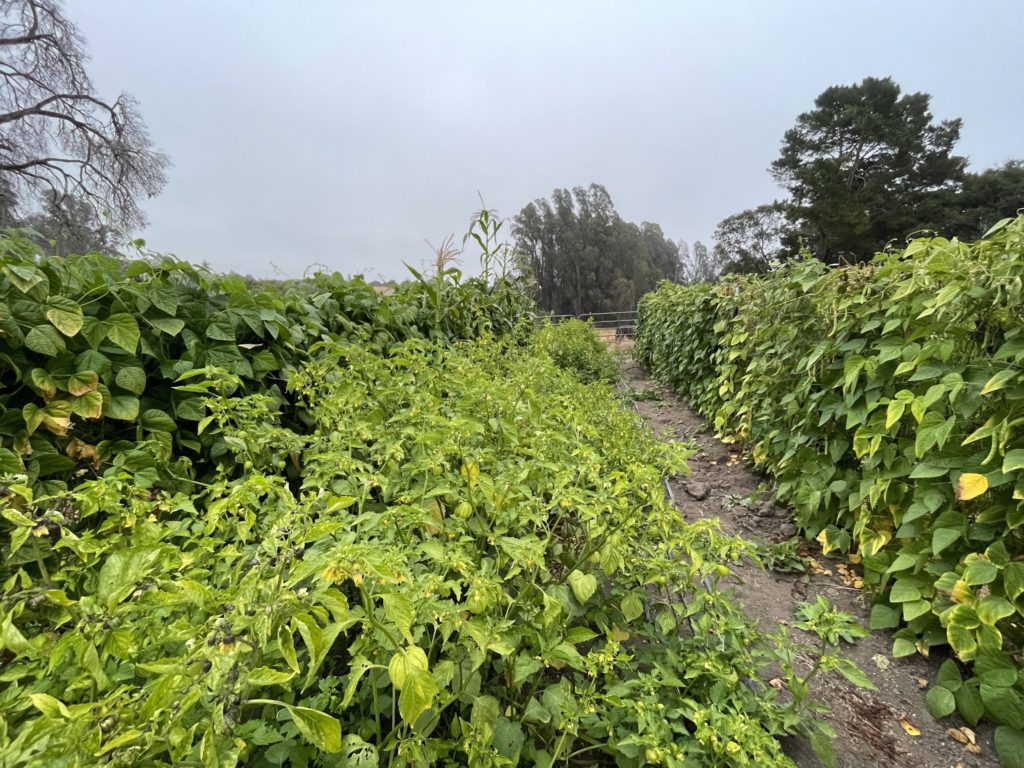
Tomatillo de milpa growing as a thicket of weeds among the rows of Oaxacan beans.
© 2022 Essay and photos by Andy Griffin
Just Around the Corner
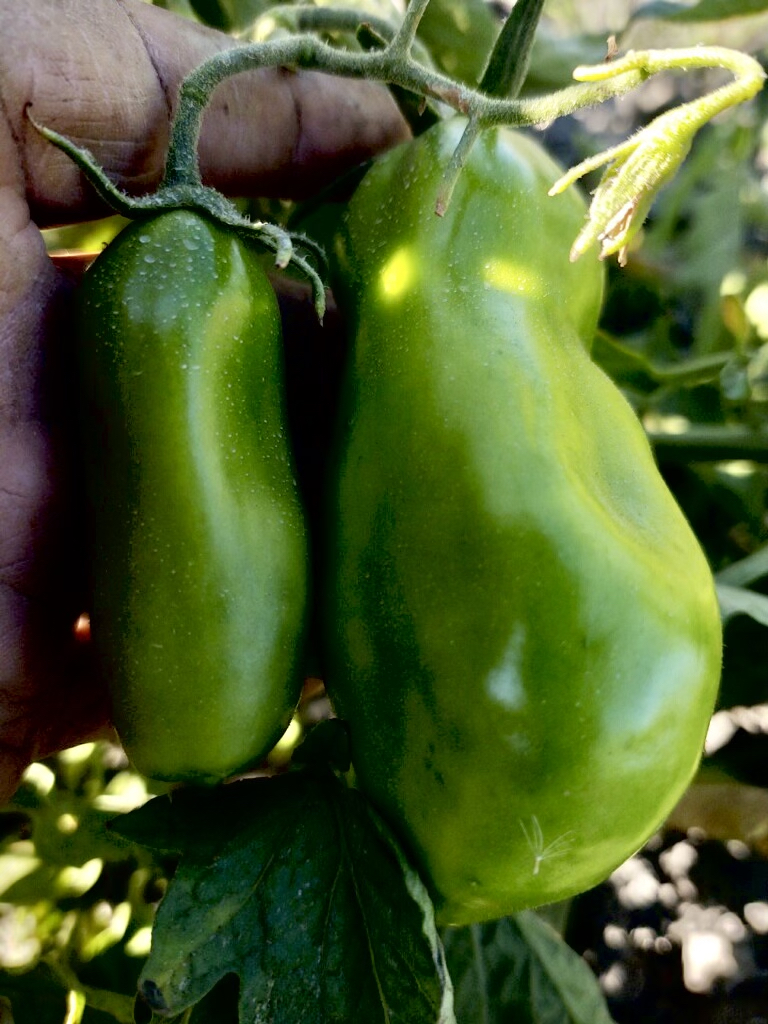
Green, unripe San Marzanos on the vine.
Broadly speaking, there are two principal categories of tomatoes; “determinate,” and “indeterminate.” Once a determinate tomato plant has matured, it sets all the flowers it’s ever going to have in one big flush. A pollinated tomato flower is just an impregnated embryo dressed up in a skirt of petals. So, just as a determinate tomato sets all of its flowers at one time, it follows that the fully developed fruits all mature at once. I don’t have anything against determinate tomatoes, but I don’t grow them. Determinate varieties of tomato are best suited for large scale farming operations that mechanically harvest their crops. The machines that harvest the tomatoes make one pass through the field, mowing down the plants and shaking the fruits from the vines and they leave a tangled mess of thrashed vines in their wake. Machine harvesting is cheaper than picking the crop by hand, but if a farmer wants to have a series of harvests of determinate tomatoes they need to plant a series of successive crops. Mechanized harvests of determinate tomatoes make the most sense for farms that are big enough to afford the machines and have enough space for a series of plantings. Determinate tomato breeds find their highest purpose in producing the tons and tons of fruit that are needed for processed tomato production. Most tomato juice, tomato sauce, and canned tomatoes that are commercially available come from determinate varieties. The clockwork precision with which these modern, determinate tomato varieties mature on a schedule allows canneries to operate with production contracts that guarantee a steady flow of raw, cheap product into their factories. My farm is tiny and I serve a local community of home cooks who are doing their own canning, so determinate varieties are not relevant to our needs.
 We grow indeterminate varieties of tomato. We are picking by hand and we have a small crew doing all the work so it makes sense for us to grow varieties of tomatoes that live for a long season and yield a modest crop of fruit week after week. That said, we usually make two or three separate plantings of each variety of tomato over a period of eight weeks so that we can be more assured of a steady harvest. And planting several sets of indeterminate tomatoes helps us guarantee that we will have a crop to sell, even if we suffer some problem in the field, like a destructive heat wave, a devastating fungal blight, a plague of pest insects, or an unseasonal heavy rain. At one time or another in the past we have suffered each of these environmental dramas. Luckily, this year, so far at any rate, the slot machine we call a tomato farm has been coming up cherries. In fact, since cherry tomatoes are small and they ripen fast compared to their larger cousins, they’re always our first tomato. Our early crop of cherry toms is kicking in now, and we’ll have two more plantings to pick after this first planting is slowing down. If we lived in the tropics where it never frosts, these cherry tomato plants would likely live for several years. Up here on the 38th parallel the cold weather of late fall will eventually kill them but, with any luck, we’ll have cherry tomatoes all the way to Halloween, and in an exceptional year we may even have a few baskets for Thanksgiving.
We grow indeterminate varieties of tomato. We are picking by hand and we have a small crew doing all the work so it makes sense for us to grow varieties of tomatoes that live for a long season and yield a modest crop of fruit week after week. That said, we usually make two or three separate plantings of each variety of tomato over a period of eight weeks so that we can be more assured of a steady harvest. And planting several sets of indeterminate tomatoes helps us guarantee that we will have a crop to sell, even if we suffer some problem in the field, like a destructive heat wave, a devastating fungal blight, a plague of pest insects, or an unseasonal heavy rain. At one time or another in the past we have suffered each of these environmental dramas. Luckily, this year, so far at any rate, the slot machine we call a tomato farm has been coming up cherries. In fact, since cherry tomatoes are small and they ripen fast compared to their larger cousins, they’re always our first tomato. Our early crop of cherry toms is kicking in now, and we’ll have two more plantings to pick after this first planting is slowing down. If we lived in the tropics where it never frosts, these cherry tomato plants would likely live for several years. Up here on the 38th parallel the cold weather of late fall will eventually kill them but, with any luck, we’ll have cherry tomatoes all the way to Halloween, and in an exceptional year we may even have a few baskets for Thanksgiving.
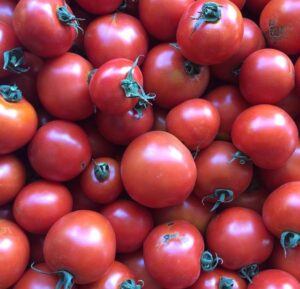 One of our main crops of larger tomatoes are the Early Girl tomatoes, which we grow without using any irrigation- a practice called “dry-farming.” When you “dry farm” a crop, you plant it early in the season while the soil still has a lot of moisture near the surface. As the air temperatures rise and subsoil water level recedes, the tomato plants send their roots deeper and deeper into the soil as they chase the water down. Deeper soil typically has less humus in it and more minerality. Flavor in fruit and color in flowers doesn’t come from the nitrogen, potassium and phosphorus that promote vegetative growth so much as from the trace elements of various minerals available in the soil. Any wine grower can wax eloquent about “terroir,” but what they’re really talking about is flavor as an expression of local minerality. Fruit from the same breed of plant grown in different terrain will taste different due to the different spectrum of trace elements that the plants take up, as well as the consequence of varying local climatic conditions. Sicily has won wide fame around the world for the flavor of its tomatoes, and while Latin pride may account for a certain amount of bragging, there’s no doubt that the volcanic ash from Mt Etna has blessed Sicily with an amazing profile of minerals and trace elements that enrich the soil. We can’t compete with Sicily because we have no Etna nearby, but we are at almost the same latitude as Ragusa, Sicily, we enjoy a Mediterranean climate that is similar to theirs. When we dry farm our tomatoes we get their roots down past our super rich topsoil and into the mineral zone. Early Girls come “early,” and we’ll make our first pass through the field on Monday, but it will likely be a few more weeks until we see our first meaningful harvests.
One of our main crops of larger tomatoes are the Early Girl tomatoes, which we grow without using any irrigation- a practice called “dry-farming.” When you “dry farm” a crop, you plant it early in the season while the soil still has a lot of moisture near the surface. As the air temperatures rise and subsoil water level recedes, the tomato plants send their roots deeper and deeper into the soil as they chase the water down. Deeper soil typically has less humus in it and more minerality. Flavor in fruit and color in flowers doesn’t come from the nitrogen, potassium and phosphorus that promote vegetative growth so much as from the trace elements of various minerals available in the soil. Any wine grower can wax eloquent about “terroir,” but what they’re really talking about is flavor as an expression of local minerality. Fruit from the same breed of plant grown in different terrain will taste different due to the different spectrum of trace elements that the plants take up, as well as the consequence of varying local climatic conditions. Sicily has won wide fame around the world for the flavor of its tomatoes, and while Latin pride may account for a certain amount of bragging, there’s no doubt that the volcanic ash from Mt Etna has blessed Sicily with an amazing profile of minerals and trace elements that enrich the soil. We can’t compete with Sicily because we have no Etna nearby, but we are at almost the same latitude as Ragusa, Sicily, we enjoy a Mediterranean climate that is similar to theirs. When we dry farm our tomatoes we get their roots down past our super rich topsoil and into the mineral zone. Early Girls come “early,” and we’ll make our first pass through the field on Monday, but it will likely be a few more weeks until we see our first meaningful harvests.
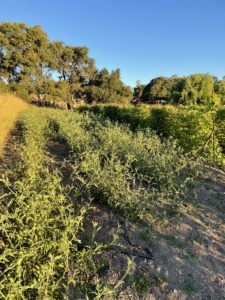
Piennolo crop. There’s lots of fruit out there.
Another crop that we dry farm are the Piennolo tomatoes. You may have seen Piennolo tomatoes in magazine articles about the food traditions of Italy. There is the custom of pulling the green Piennolo plants up by the roots at the end of the season when the cold weather approaches and hanging the vines from the ceilings of Italian kitchens and the green fruits will supposedly ripen within the reach of the cook’s outstretched arms during the winter. We got our seed from my friend, Annabelle, who manages Star Route Farm in Bolinas. As near as I can tell, this variety is very similar to the Principe Borghese tomato that we have grown in the past. Besides being useful as a fresh ingredient, Piennolo tomatoes are also much esteemed as the best crop for sun dried tomatoes. Being as we dry farm our Piennolo tomatoes, the fruits don’t have excessive moisture to begin with, and we plan on drying a quantity of ours and packing them in the local Belle Farms olive oil. We will have some dried Piennolo for sale late this fall, but we will have plenty to sell fresh too in case you want to dry or can your own. The crop looks great so far, but they are never “early,” and I imagine we’ll see our first good harvests by the beginning of August.
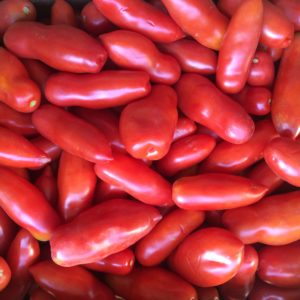 Our crop of San Marzano tomatoes are doing fine too. (Photo at top of unripe green San Marzanos). San Marzanos are much appreciated by consumers because their dense, sweet flesh makes for a wonderful sauce. You don’t see San Marzanos so often in major retail settings here because the “sauce niche” is typically covered by cheap, mass produced determinate varieties, but the San Marzano is an iconic Italian variety and you can see it’s distinctive, long, bullet shaped image on the labels of a million cans of imported tomato sauce. It could be that many US growers steer away from raising San Marzanos because the vines can be subject to various diseases. Since we’ve lost a crop or two over the years we take care to plant several sets of San Marzano each year in case we lose one. It’s so far, so good for our San Marzano crop this season, and I expect the first harvests by late July or early August. The heaviest harvests will fall through September and early October, but the first harvests are just around the corner, so buy your jars and make your plans now.
Our crop of San Marzano tomatoes are doing fine too. (Photo at top of unripe green San Marzanos). San Marzanos are much appreciated by consumers because their dense, sweet flesh makes for a wonderful sauce. You don’t see San Marzanos so often in major retail settings here because the “sauce niche” is typically covered by cheap, mass produced determinate varieties, but the San Marzano is an iconic Italian variety and you can see it’s distinctive, long, bullet shaped image on the labels of a million cans of imported tomato sauce. It could be that many US growers steer away from raising San Marzanos because the vines can be subject to various diseases. Since we’ve lost a crop or two over the years we take care to plant several sets of San Marzano each year in case we lose one. It’s so far, so good for our San Marzano crop this season, and I expect the first harvests by late July or early August. The heaviest harvests will fall through September and early October, but the first harvests are just around the corner, so buy your jars and make your plans now.
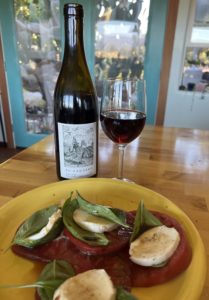
Caprese salad.
Our heirloom tomatoes are about to start too. The Cherokee Purples are always the earliest color to present itself in the spectrum, and we harvested half a dozen boxes last week, which is a good first pass. The Pink Brandywines, Yellow Brandywines, and Marvel Striped tomatoes will follow. We have lots of fresh basil planted, so Caprese salad is just around the corner too. We had a trial run on a Caprese salad in our own kitchen last night and enjoyed it with a bottle of wine from our neighbors at El Vaquero winery. They’ve opened up a tasting room with live music and trivia nights just around the corner from our home farm in Corralitos- and next to our friends at Alladin Nursery who are letting us set up our “honor stall flower stand” in front of their store. Thanks, Gustavo and Alladin staff. Starr has been making herb salt in advance of the harvest so that when the fresh crop comes we have some to sell. Herbed salt brings out a delightful taste in the tomatoes. She also has been preparing a wide range of dried herbs for all the canners out there, like oregano, thyme and marjoram. Get ready now while we have lots in stock. And stay tuned for an upcoming Tomato Palooza in an area near you. We’re also planning a U-Pick event at our home ranch this fall for our dry-farmed Piennolo tomatoes. Keep an eye on the newsletters for updates.
Thanks, Andy and the Crew at Mariquita
© 2022 Essay by Andy Griffin
Photos by Andy Griffin and Starling Linden
Where Has All the Water Gone
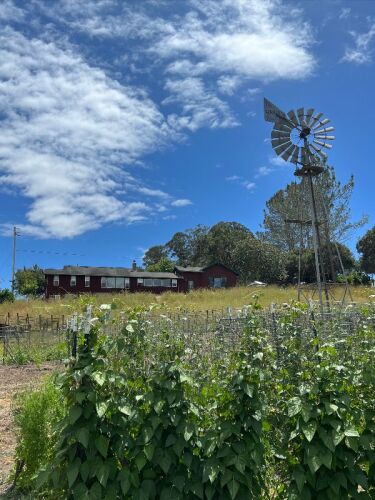
Windmill at Mariquita Farm
Water witching works like a charm. Or not. Some people call the ancient practice “dowsing.” Others call it “magic.” It works like this; cut a young, but firm, forked branch from a tree- preferably a willow if you’re dowsing for water- and trim it so that it is shaped like a “Y” with each arm or leg about 12 to 18 inches long. Grasp your forked branch with both hands, palms up, each hand holding on to one of the outstretched arms of the Y, and with the leg of the Y pointing out in front of your body like the bowsprit of a sailing ship. Keep your willow “bowsprit” level in front of you as you walk around the area in which you are searching for water. If you are sensitive — and if there is a hidden water deposit below — the witching wand will dip down to point to the underground water source as you pass over.
Archeologists will tell you that people have been divining the presence of water in this way for thousands of years. There are images that depict these dowsers at work carved in the walls of Egyptian tombs and scratched down in antique Chinese etchings. Some people even swear by dowsing as a way to find other hidden resources, like underground veins of gold or lost cell phones. But other people think that dowsers are frauds, or worse. Over the years I’ve asked a number of professional well diggers what they think.
Jack Edsberg dug my newer well twenty five years ago. He was one of four different well diggers I sought bids from, and it was interesting to see how little they varied in what they all said to me. I’ll quote (or paraphrase) Jack and let him speak for all the well diggers I’ve met, because they seemed to speak like a chorus in a Greek tragedy. In fact, the only difference between what any of them said was the price they asked for their services. In the end, I went with Jack Edsberg, not because he was the cheapest, but because he’d also been a local farmer for many years, and I got along well with him.
“Andy,” he said. “It doesn’t really matter if dowsing works or not. If you want an electric pump you’re going to have to dig the well near an existing power drop, because lawyers, guns, and money aren’t enough to get PG&E to extend a new line these days. You’d need lots of time for them to get that done, so if you want water in this life you’ll dig next to an existing power pole. And since the county has a mandatory setback of 25 feet from any property line for any new well, and since this pole is the end of the line for PG&E, you’re going to want to dig here.” And he pointed to the same spot, 30 feet from our property line, 20 feet from the power line, and 10 feet from my house that every other well digger had pointed to. “Also,” he said, “I charge by the foot, whether or not I hit water.”
Well diggers are careful not to promise that they will find water for you. But they’ll usually offer an informed opinion on what they think is going on under the ground. Here too, I found that the well diggers spoke in unison. “We’re going to get some water within the first 50 feet,” Jack said, “but we’re going to drill right past it. It’s just surface water, and we’re aiming for a bigger aquifer that’s around 160 feet down. It’ll have better water and more of it. It’s an aquifer that’s flowing down from the Sierras.” Our house is at about 38 feet elevation and we’re about three miles from the coastline, as the seagull flies, so I’d imagine any water flowing past under our house will seep into the ocean at about 140 feet under the waves. It was surprising- and sobering- to find out our water comes from the Sierra. When you think about it, my farm is pretty close to the end of the line for this underground river, and there are LOTS of pumps “upstream” between our fields and the Sierra snowpack.
Jack did hit a modest flow of water through a vein of gravel about 25 feet below the surface and then the drill bit into a deep and dense layer of clay. He poured a plug of concrete around the well shaft to keep any of the surface water from draining down into any deeper aquifer. At around 160 feet below the surface he hit the first trace of the water he was looking for and he stopped drilling at 250ft. With the pump installed I was drawing twenty gallons a minute from 160 feet, with a 70 foot column of water below. Everything went just as every well digger had projected. They get around, and an old well digger, like Jack, has been to many, many wells over the landscape and over the years as they do their work digging or repairing wells, and they keep notes. Sometimes talking to them can be eye-opening.
During the last drought I had an emergency with my newer well, and I feared I’d run out of water. Jack had passed away, but the well digger that took my call could have been his brother. “It’s a pump problem,” he told me after some preliminary tests. “You’re looking good water-wise with about 10 gallons a minute, pumping from 180 feet down.”
That didn’t sound so good to me since we’d been pumping twice as much per minute from 20 feet higher twenty years before. So our water table had dropped considerably. I was telling the well service guy all about my worries, but he put a hand up and told me to relax.
“I just came from a job off of San Miguel Canyon, where it comes into the Valley by the railroad, and the fellow there said his pump had burned out. The pump was fine but his well was dry- and they were pumping from 750 feet.”
That was alarming news. I have farmed out in that neighborhood, and that area used to be a wetlands, crawling with crawdads, frogs, and turtles. It’s my understanding that those wetlands were drained for farming by the Slavic immigrants who came into the Watsonville area in the late 1800s from the Adriatic. The flooded land was cheap because the Gringos didn’t want it for their cattle pasture and it didn’t have redwoods for logging, so the Slavs bought it, drained it, and were rewarded with some of the richest farmland you can imagine. You still see the Slavic names all over town; Scuritch, Marinovitch, Matulich, Pavitch, etc. Their ancestors laughingly call themselves the “Sons of Vitches”, and quite a few of them are still farming.
In 1990 I was farming out in that neighborhood and our farming neighbor across the road was a very successful conventional grower named Bukonovitch. His label was “Boogie Woogie,” and his cartons had the outline of a saxophone printed on the sides. But “Boogie,” as he was known, lost all his jazz cool when he found out that we were growing vegetables organically right across the road from him. “You can’t do that,” he hollered at us, all red-faced and agitated. He was worried that we’d “infect” his crops with all the pests we were breeding and harboring. Boogie thought that organic growing couldn’t be done and we were dirtbag hippies for even trying. There was no reasoning with him. “But we’re doing it!” we replied. Nowadays organic farming is widespread across the Pajaro Valley. But clearly water supply is a looming problem, even if the crisis is underground and out of sight.
It would be good if everybody learned more about the security and stability of their own water supply. Now that I know my water table has dropped by a foot a year I’m certainly more aware of water and how much I’m using. We are not going to have enough water in the future for everybody in California to do what they like, so controls are inevitable and hard policy choices will have to be made. Does it make sense to use the state’s scarce water resources to irrigate alfalfa for an overseas market? Or, why should we, the public, watch as the water table in the Central Valley is drained to grow almonds for export by a few large landowners, when that water might be more equitably shared among numerous interests, including communities and wildlife? Or, have we ever looked honestly at what the impact is on our environment of turning so much “water into wine.” In a future newsletter I’ll tell you a counterintuitive and happy story about our older well.
© 2022 Essay by Andy Griffin
Photo by Starling Linden
